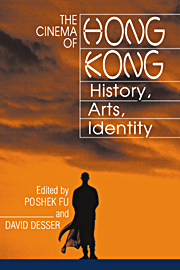Book contents
- Frontmatter
- Contents
- List of Contributors
- Acknowledgments
- Introduction
- Chronology of Hong Kong Cinema
- PART I HISTORY
- PART II ARTS
- 5 Richness through Imperfection: King Hu and the Glimpse
- 6 Space, Place, and Spectacle: The Crisis Cinema of John Woo
- 7 Besides Fists and Blood: Michael Hui and Cantonese Comedy
- 8 The Film Work of Ann Hui
- PART III IDENTITY
- Index
6 - Space, Place, and Spectacle: The Crisis Cinema of John Woo
Published online by Cambridge University Press: 05 June 2012
- Frontmatter
- Contents
- List of Contributors
- Acknowledgments
- Introduction
- Chronology of Hong Kong Cinema
- PART I HISTORY
- PART II ARTS
- 5 Richness through Imperfection: King Hu and the Glimpse
- 6 Space, Place, and Spectacle: The Crisis Cinema of John Woo
- 7 Besides Fists and Blood: Michael Hui and Cantonese Comedy
- 8 The Film Work of Ann Hui
- PART III IDENTITY
- Index
Summary
So I wanted to make a film that would emphasize traditional values: loyalty, honesty, passion for justice, commitment to your family. Things I felt were being lost.
Like most national cultures today, Hong Kong cinema is undergoing a process of transformation influenced by historical, political, and geographical factors that are forcing its practitioners to question its very identity. The most dominant factor is the handover of the former British colony to the Chinese government. Although Hong Kong's hybrid nature has long been obvious to students of this cinema, the last decade has seen the emergence of a particular apocalyptic and highly cinematic body of work that is responsive to a future historical situation that emerged during the 1990s.
Certain features of Hong Kong cinema are by no means new to those who remember the martial arts boom of the 1970s. While Bruce Lee's The Big Boss (1971) and Fist of Fury (1972), respectively, dealt with contemporary and historical themes of industrial exploitation and outside (Japanese/Russian) involvement in 1920s Chinese politics, Enter the Dragon (1973), Return of the Dragon (a.k.a. Way of the Dragon (1973), and the posthumous Game of Death (1974) contained more Western-oriented treatments with frequent homages to Hollywood (the “Lady from Shanghai” mirror sequence in Enter the Dragon) and contemporary cinematic genres (as seen in Chuck Norris's cowboy persona “Colt” and accompanying Ennio Morricone “Frank” theme from Sergio Leone's Once Upon A Time in the West featured in Return).
- Type
- Chapter
- Information
- The Cinema of Hong KongHistory, Arts, Identity, pp. 137 - 157Publisher: Cambridge University PressPrint publication year: 2000
- 1
- Cited by

